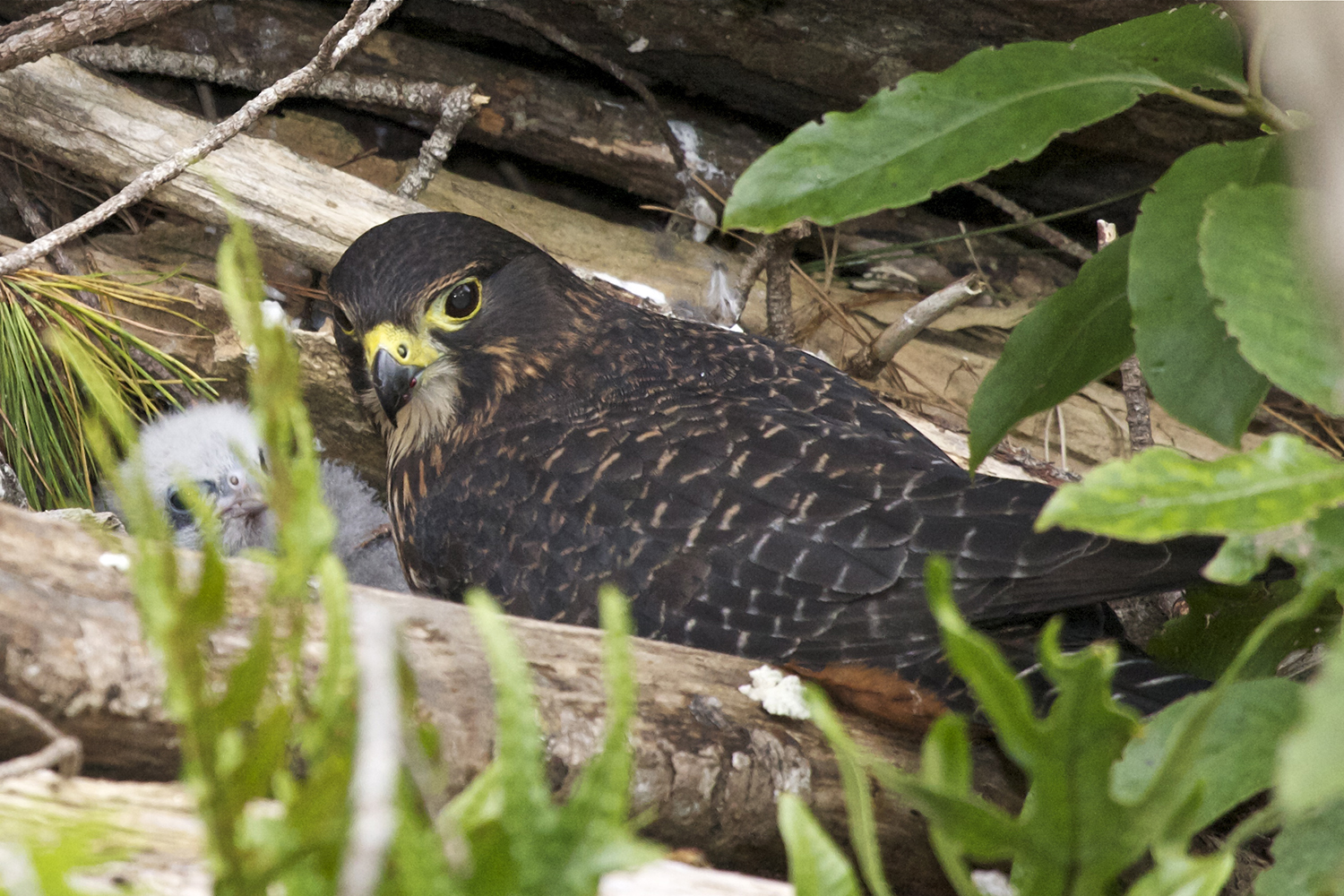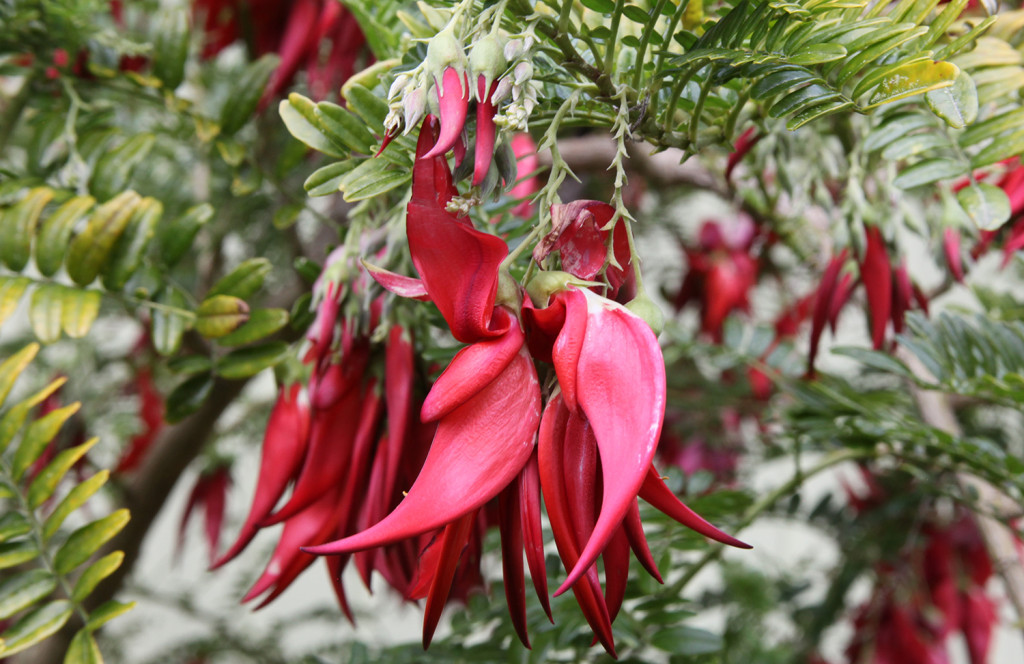Radiata pine forests stretch across nearly two million hectares of New Zealand. Many find them dark, monotonous and sterile, but appearances can be deceiving. Native flora and fauna, including endangered and threatened species, happily make their homes in planted forests.
At least 118 threatened indigenous species are found in the mix of exotic forest and native ecosystems remnants that make up plantation habitats. Oddly precise, the number 118 was arrived at by Scion scientists after reviewing accessible literature, databases and forestry company records. And the number is probably on the low side; it is expected to increase as more research and surveys are carried out.
Two thirds of species identified were plants, especially shade tolerant and understory plants, and those that grow in disturbed ground like ngutukaka (kakabeak). Fish in shaded forest streams, rare beetles, carnivorous snails and other invertebrates, lizards and frogs, birds and New Zealand’s only two endemic mammals are also on the list.
Bats
Two species of bat remain in New Zealand. Both are highly endangered and both can be found in planted forests.
Long-tailed bats have been seen in at least 26 exotic forests from Northland to South Canterbury, with the heaviest populations in and around the central North Island. They choose home ranges in forests with older trees that provide roosting sites and find insect-rich hunting grounds along the edges of forest stands, roads and streams.
Short tailed bats are much rarer and, unusually, spend time hunting and foraging on the ground. They also use radiata forests in the central North Island for feeding, commuting and roosting, especially those adjacent to areas of native forests or with native remnants and reserves within plantations.
Little is known about how bats use exotic forests or how forest management activities affect them. As the tools for locating bats improve, it is likely more populations will be found and research will identify ways to help them thrive in their adopted environment.
Birds
The identity of some of the threatened birds living in planted forests is a little surprising.
The North Island brown kiwi and the great spotted kiwi are known to use all parts of exotic forests, from slash piles to newly planted to mature stands, and even skid sites. Forest harvesting can be a threat during the breeding period, but this can be avoided with sympathetic scheduling.
Alpha predators also flourish in planted forests. The highest breeding density in the country of karearea (bush falcons) is found in Kaingaroa Forest. Forest managers and others monitor falcon activity in the forest to reduce the risk of forestry activities disturbing them. Factors that seem to favour the falcon, which nests on the ground, are the abundant high quality and sheltered nesting sites created by recent harvesting, as well as a high prey density and the periodic pest control carried out in forests.
How and why planted forests help diversity
Nesting and roosting sites, food and protection are some of the benefits provided by planted forests. Less obvious is that planted forests ‘reverse’ one of the main causes of biodiversity loss – forest loss and fragmentation – by functioning as safe and green corridors connecting the remnants of indigenous ecosystems. Even being nearby to an unconnected fragment can encourage ‘traffic’ by reducing the amount of open space that has to be negotiated.
Neighbouring plantations are also used as supplementary/complementary habitat extensions by species that are more at home in native forests. Kokako and kaka, for example, visit nearby planted forests to feed. Kaka particularly enjoy stripping bark from conifers to access tree sap.
Planted forests also reduce ‘edge’ effects and maintain deep forest-like conditions in neighbouring patches of native forest. A buffer against bad weather, a surrounding plantation creates and maintains light conditions, temperatures and microclimates similar to those found in deep within a forest.
Introduced pest numbers may also be lower in planted forests. While the effects of predators and grazing animals have been well studied in native forests, not much is known about their number and control in planted forests. However, there are suggestions predation may be less intense, either naturally and/or due to periodic pest control operations.
Valuing biodiversity in planted forests
The biodiversity of planted forests is almost invisible. The conservation emphasis in New Zealand is usually on preserving native or indigenous species and ecosystems. However, recent work by Scion ecosystem services scientists and others has shown New Zealanders do value biodiversity in planted forests. The researchers found a typical New Zealand respondent (from a sample of more than 200 respondents) would be willing to pay about $63 per year for a conservation programme that would increase the abundance of key native species (e.g. kiwi) in exotic forests.
Being able to assign a value to biodiversity can help forest owners quantify the benefits of different conservation options and opportunities, and to make decisions on how best to manage the mix of commercial and native ecosystem remnants that are frequently found in planted forests.
As the value of biodiversity is clarified and quantified, it will be easier to compare and contrast how shifts in land use could affect biodiversity and to make choices that consider factors beyond gross profit. For example, planting forests in landscapes where the natural vegetation is grass or open scrub, or in wetlands, could be more detrimental to biodiversity than agriculture. Conversely, planting in areas where natural forest has been lost will promote more biodiversity than pastoral and agricultural activities.
Conservation, biodiversity and planted forests
The contribution that planted forests make to conservation is recognised by organisations such as the Forest Stewardship Council (FSC), which certifies forests adhering to certain principles as sustainable. To become FSC-certified, forest owners and managers need to actively manage native remnants and threatened species throughout their entire estate (including commercial stands). The FSC also specifies a minimum proportion of indigenous ecosystems within certified forests. Where these are not present, foresters are required to restore additional indigenous habitat. The amount of land set aside for this varies from forest to forest from about 5% to more than 30%.
About 50% of the New Zealand forest estate is FSC-certified. Many forest owners and companies go above and beyond the requirements of certification and are very active in monitoring and promoting biodiversity.
One example of active conservation management is maintaining the genetic diversity of wild populations of ngutukaka. Found in steep gullies on the edge of pine stands on the East Coast, ngutukaka is extremely vulnerable to browsers like feral deer and goats. The species has benefitted from active pest (goat) control by the forestry companies managing these areas. Local companies are also using ngutukaka in their indigenous habitat restoration projects.
Forest managers can also enhance biodiversity and conservation by minimising the impacts of forestry operations on the local flora, fauna and environment. Ways in which they can achieve this include avoiding intensive site preparation, spacing trees widely when planting, thinning heavily to help maintain understory vegetation and scheduling harvesting so it does not interrupt breeding seasons.
Forest harvesting is the most disruptive operation. It removes habitat and can leave previously protected ecosystems exposed. An effective way to minimise the impacts of harvesting is to leave buffer zones around indigenous ecosystems to maintain microclimates. A second benefit a buffer zone is an increasing number of older trees offering roosting options for bats and cavity-nesting birds. Similarly, buffer zones on riparian strips help keep conditions constant in forest streams and reduce the amount of sediment and slash that could be washed away in floods.
Forest roadsides can also be used as buffer areas. Planting them with native plants, especially those that supply nectar and berries, will encourage other species to use the edges of planted forests and present a familiar New Zealand bush scape to the public.
Forests for our future
Recognising that exotic forests are rich in biodiversity and have roles to play in conservation is a new way of thinking about an ecosystem involved in production. A better appreciation of how indigenous flora and fauna use planted forests and neighbouring ecosystems, and appropriate management of these, will enable both threatened and other species to flourish, grow and spread. Not dark, monotonous or sterile, planted forests are contributing to a countryside increasingly rich in biodiversity, preserving both New Zealand’s heritage and securing its future.





Leave a comment